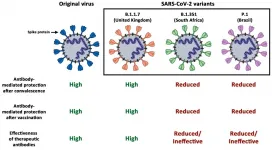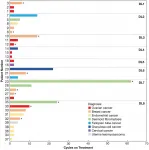(Press-News.org) The Miscanthus genus of grasses, commonly used to add movement and texture to gardens, could quickly become the first choice for biofuel production. A new study shows these grasses can be grown in lower agricultural grade conditions - such as marginal land - due to their remarkable resilience and photosynthetic capacity at low temperatures.
Miscanthus is a promising biofuel thanks to its high biomass yield and low input requirements, which means it can adapt to a wide range of climate zones and land types. It is seen as a viable commercial option for farmers but yields can come under threat from insufficient or excessive water supply, such as increasing winter floods or summer heat waves.
With very little known about its productivity in flooded and moisture-saturated soil conditions, researchers at the Earlham Institute in Norwich wanted to understand the differences in water-stress tolerance among Miscanthus species to guide genomics-assisted crop breeding.
The research team - along with collaborators at TEAGASC, The Agriculture and Food Development Authority in the Republic of Ireland, and the Institute of Biological, Environmental and Rural Sciences in Wales - analysed various Miscanthus genotypes to identify traits that provided insight into gene adaptation and regulation during water stress.
They found specific genes that play key roles in response to water stress across different Miscanthus species, and saw consistencies with functional biological processes that are critical during the survival of drought stress in other organisms.
Dr Jose De Vega, author of the study and Group Leader at the Earlham Institute, said: "Miscanthus is a commercial crop due to its high biomass productivity, resilience, and ability to continue photosynthesis during the winter months. These qualities make it a particularly good candidate for growth on marginal land in the UK, where yields might otherwise be limited by scorching summers and wet winters."
Previously, a decade-long trial in Europe showed that Miscanthus produced up to 40 tonnes of dry matter per hectare each year. This was reached after just two years of establishment, proving its biofuel capacity was more efficient in ethanol production per hectare than switchgrass and corn.
Miscanthus species have been used as forage species in Japan, Korea and China for thousands of years and, due to its high biomass yield and high ligno-cellulose (plant dry matter) content, they are commercially used as feedstock for bioenergy production.
Ligno-cellulose biomass is the most abundantly available raw material on Earth for the production of biofuels, mainly producing bio-ethanol. Miscanthus's high biomass ability makes the grass a valuable commodity for farmers on marginal land but the crop's responses to water-stress vary depending on the Miscanthus species' origin.
The scientists compared the physiological and molecular responses among Miscanthus species in both water-flooded and drought conditions. The induced physiological conditions were used for an in-depth analysis of the molecular basis of water stress in Miscanthus species.
A significant biomass loss was observed under drought conditions in all of the four Miscanthus species. In flooded conditions, biomass yield was as good as or better than controlled conditions in all species. The low number of differentially expressed genes, and higher biomass yield in flooded conditions, supported the use of Miscanthus in flood-prone marginal land.
"The global challenge of feeding the ever-increasing world population is exacerbated when food crops are being used as feedstock for green energy production," said Dr De Vega.
"Successful plant breeding for ethanol and chemical production requires the ability to grow on marginal lands alongside prioritising the attributes; non-food related, perennial, high biomass yield, low chemical and mechanical input, enhanced water-use efficiency and high carbon storage capacity. Miscanthus fulfils these for enhanced breeding - saving money and space for farmers, and lending a hand to our over polluted environment by emitting CO2.
"The research team is in the early selection process of high biomass genotypes from large Miscanthus populations that are better adapted to the UK conditions and require low inputs. The use of genomic approaches is allowing us to better understand the traits that make some Miscanthus species a commercially sustainable alternative for marginal lands and applying this to agri-practices."
INFORMATION:
The paper 'Physiological and transcriptional response to drought stress among bioenergy grass Miscanthus species' is published in Biotechnology for Biofuels.
Energy models are used to explore different options for the development of energy systems in virtual "laboratories". Scientists have been using energy models to provide policy advice for years. As a new study shows, energy models influence policymaking around the energy transition. Similarly, policymakers influence the work of modellers. Greater transparency is needed to ensure that political considerations do not set the agenda for future research or determine its findings, the researchers demand.
Renewable energies bring many changes, including fluctuations in the energy supply and a more geographically distributed generation system. ...
A collaborative research project by team of undergraduate students from the University of Exeter's Natural Sciences department has been published in a prestigious academic journal.
Lewis Howell, Eleanor Osborne and Alice Franklin have had their second-year research published in The Journal of Physical Chemistry B.
Their paper, Pattern Recognition of Chemical Waves: Finding the Activation Energy of the Autocatalytic Step in the Belousov-Zhabotinsky Reaction, was a result of their extended experiment work in the Stage 2 module "Frontiers in Science 2".
Their project involved the Belousov-Zhabotinsky chemical reaction - an ...
March 7, 2021, KAUST, Saudi Arabia - KAUST Assistant Professor of Computer Science Mohamed Elhoseiny has developed, in collaboration with Stanford University, CA, and École Polytechnique (LIX), France, a large-scale dataset to train AI to reproduce human emotions when presented with artwork.
The resulting paper, "ArtEmis: Affective Language for Visual Art," will be presented at the Conference on Computer Vision and Pattern Recognition (CVPR), the premier annual computer science conference, which will be held June 19-25, 2021.
Described as the "Affective Language for Visual Art," ArtEmis's user interface has seven emotional descriptions on average for each image, bringing the total count to over 439K emotional-explained attributions from humans on ...
While urban agriculture can play a role in supporting food supply chains for many major American cities -- contributing to food diversity, sustainability and localizing food systems -- it is unrealistic to expect rooftop gardens, community plots and the like to provide the majority of nutrition for the population of a metropolis.
That's the conclusion of a team of researchers who analyzed the nutritional needs of the population of Chicago and calculated how much food could be produced in the city by maximizing urban agriculture, and how much crop land would be needed adjacent to the city to grow the rest. The study was the first to evaluate land required to meet ...
Scientists have shown that SARS-CoV-2, the virus that causes COVID-19, can infect specific cells in the salivary gland in the mouth. The study by researchers from the Wellcome Sanger Institute, National Institutes of Health and the University of North Carolina at Chapel Hill, and their collaborators within the Human Cell Atlas Oral & Craniofacial Network, also discovered that live cells from the mouth were found in saliva, and that the virus was able to reproduce within these infected cells.
The study revealed that salivary gland cells could play a role in transmission ...
Göttingen, March 25, 2021. Testing and vaccination - these are the pillars on which humanity is trying to get a grip on the Coronavirus pandemic. Although it is taking longer than many had expected, it is believed that it is only a matter of time before we are all vaccinated and thus protected. However, time is also working for the virus, which has now mutated several times, with variants B.1.1.7 from the United Kingdom, B.1.351 from South Africa and P.1 from Brazil spreading rapidly. These viruses have mutations in the so-called spike protein, the structure on the surface of the virus that is responsible for attachment to host cells. At the same time, the spike protein is also the major target of the immune response. Antibodies generated in response to SARS-CoV-2 infection or vaccination ...
Supersized alcopops are ready-to-drink flavored alcoholic beverages with high alcohol content that are disproportionately consumed by underage drinkers. There can be up to 5.5 standard alcoholic drinks in a single 24 ounce can, so consuming only one can of supersized alcopop is considered binge drinking, and consuming two cans can cause alcohol poisoning. Still, these products remain under-regulated and are available inexpensively at gas stations and convenience stores, where they are more readily accessible by underage youth.
New research led by George Mason University's College of Health and Human Services found that nearly ...
The burial field in Valsgärde outside Uppsala in central Sweden contains more than 90 graves from the Iron Age.
"On a light note, we could say that Valsgärde is Scandinavia's answer to Sutton Hoo in England as portrayed in the film The Dig on Netflix," says Birgitta Berglund, professor emeritus of archaeology at the Norwegian University of Science and Technology's NTNU University Museum.
Valsgärde is especially known for its spectacular boat graves from the 600s and 700s CE. This timeframe is in the middle of what Norway calls the Merovingian period, the era just before the Viking Age.
Two of these spectacular boat graves are at the centre of this story -- or more specifically, the story is really about the down bedding that was found ...
Oncotarget published "Phase 1 study of Z-Endoxifen in patients with advanced gynecologic, desmoid, and hormone receptor-positive solid tumors" which reported that Z-endoxifen administration was anticipated to bypass these variations, increasing active drug levels, and potentially benefiting patients responding sub-optimally to tamoxifen.
Patients with treatment-refractory gynecologic malignancies, desmoid tumors, or hormone receptor-positive solid tumors took oral Z-endoxifen daily with a 3 3 phase 1 dose escalation format over 8 dose levels.
Three patients had partial responses and 8 had prolonged stable disease; 44.4% of patients at dose levels 6–8 achieved one of these ...
UPTON, NY — Inspired by the mastery of artificial intelligence (AI) over games like Go and Super Mario, scientists at the National Synchrotron Light Source II (NSLS-II) trained an AI agent – an autonomous computational program that observes and acts – how to conduct research experiments at superhuman levels by using the same approach. The Brookhaven team published their findings in the journal Machine Learning: Science and Technology and implemented the AI agent as part of the research capabilities at NSLS-II.
As a U.S. Department of Energy (DOE) Office of Science User Facility located at DOE’s Brookhaven National Laboratory, NSLS-II enables scientific studies by more than 2000 researchers each year, ...




